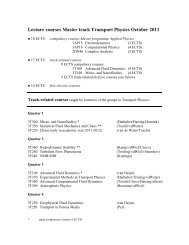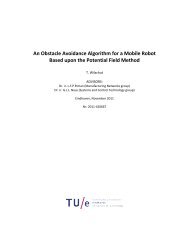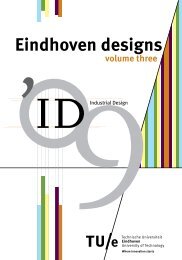Education guide 'Eindhoven designs' - Technische Universiteit ...
Education guide 'Eindhoven designs' - Technische Universiteit ...
Education guide 'Eindhoven designs' - Technische Universiteit ...
Create successful ePaper yourself
Turn your PDF publications into a flip-book with our unique Google optimized e-Paper software.
Eindhoven designs / volume two 55<br />
Self-Directed and<br />
Continuous Learning<br />
Take responsibility for and give direction<br />
to your own personal development,<br />
based on a continuous process of<br />
self-reflection and out of curiosity for<br />
future developments in technology and<br />
society.<br />
Developments in society are characterised by<br />
an enormous increase in available knowledge<br />
and information, which makes it impossible<br />
for graduates to have a complete command<br />
of their academic discipline. There is just too<br />
much to know and to learn, and what you know<br />
today may well be out of date in a number<br />
of years. Industrial Design as an academic<br />
discipline, too, is susceptible to changes.<br />
Once students have become professional<br />
designers, they will be challenged to create<br />
an environment that adapts to and supports<br />
the lives of individual people. Rather than<br />
acquiring a particular body of knowledge, this<br />
requires their ability to acquire, select and<br />
use the knowledge, skills and attitudes that<br />
they need for effective behaviour in a specific<br />
context.<br />
This, in turn, requires an attitude of openness:<br />
not only to developments in their profession<br />
and in society, but also towards the student’s<br />
own performance and learning needs in<br />
professional situations. Students graduate<br />
once but they will never stop learning. The<br />
ability to learn is at the core of becoming<br />
a life-long learner. Students should get an<br />
understanding of what learning is as an<br />
activity, discover what their preferred learning<br />
style and learning strategy is, learn how to<br />
play with various styles and strategies, and<br />
develop the skills they need to design their<br />
own learning process. This understanding<br />
should be grounded in theoretical as well as<br />
experiential knowledge.<br />
In a competency-centred programme such as ID<br />
students need to direct and manage their own<br />
competency development, learning process<br />
and learning activities: what do they want or<br />
need to learn, and what does it take to achieve<br />
it? This requires the ability to orientate oneself<br />
on what there is to learn, to set one’s own<br />
learning goals, to choose suitable learning<br />
activities (and sometimes create their own),<br />
to plan, execute and monitor these activities,<br />
to analyse one’s learning outcomes in terms<br />
of competency development and to evaluate<br />
if one has achieved the goals one sets. In the<br />
end students should also be able to selfassess<br />
their competency development and<br />
growth as a designer. Needless to say, the selfmanagement<br />
aspect of this competency only<br />
works if they take full responsibility for their<br />
own learning process.<br />
Learning – and designing – is a process of trial<br />
and error. From making mistakes, in particular,<br />
they can learn about themselves and about<br />
designing. But this takes the courage and the<br />
ability to look more closely at themselves,<br />
their learning process and learning outcomes.<br />
What knowledge and skills have they actually

















